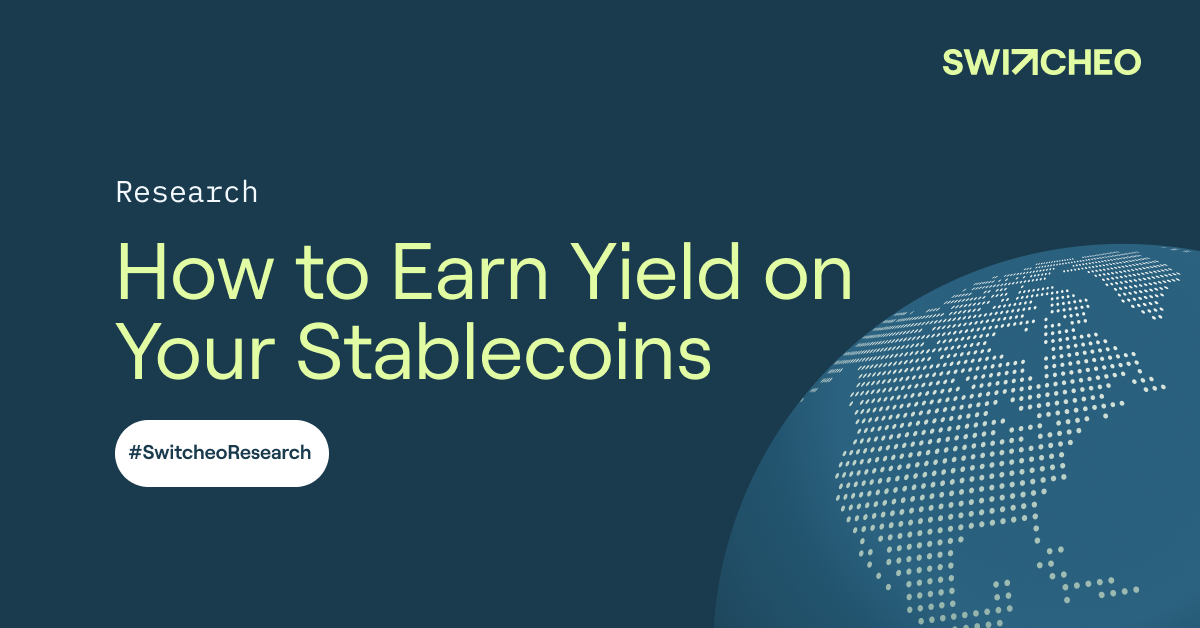Introduction
Stablecoins make up a crucial element of the crypto ecosystem. The total stablecoin market capitalisation currently sits at around $143 billion dollars. This makes up over 5% of the total cryptocurrency market valuation (which currently sits at ~2.8 trillion). For the past 7 years, the stablecoin space has been dominated by centralised projects like USDT and USDC. However, wIth the rise to prominence of DeFi, and now DeFi 2.0, numerous new decentralized stablecoin projects have risen to prominence.
Stablecoins allow cryptocurrency traders and investors to rotate profits from more volatile crypto-assets (like BTC or ETH) into a stable, fiat-pegged asset. Traders can execute trades between volatile assets and stable assets in order to maximize profits, without ever needing to off-ramp back into fiat currency. This saves them the costs of converting fiat to crypto and vice versa. With the rise to prominence of DeFi and CeDeFi (‘Centralised DeFi’), stablecoin holders can also earn relatively high interest rates on their tokens.
This article is meant to serve as a brief guide to some of the more popular stablecoins. The interest earning opportunities listed herein are by no means the most profitable. More experienced DeFi users can achieve higher interest rates by looping their stablecoin loans, and by employing various other strategies (although this does also increase the risk of loss and liquidation). The interest earning opportunities presented here are merely meant to serve as a benchmark and rough indication of how much you can potentially earn by holding stablecoins.
USDT
Market capitalisation: ~$74 billion
Whitepaper: https://tether.to/wp-content/uploads/2016/06/TetherWhitePaper.pdf
How it works:
USDT is a centralised asset-backed stablecoin. This means that a centralised entity (Tether Limited in the case of USDT) possesses the sole authority to issue new tokens into the market. These tokens are (allegedly) backed 100% by reserves held by the centralised authority.
Only customers of Tether who have passed their required KYC processes are able to exchange US dollars for USDT stablecoin, and vice versa. These USDT tokens can then be sold and exchanged on the open market, via either centralised or decentralised exchanges.
On June 30 2021, Tether released an Independent Accountant’s Report on the breakdown of its reserve holdings. According to this report, Tether Limited was in possession of $62.8 billion worth of assets. At that point in time, the circulating supply of USDT was $62.7 billion.
Here's the asset breakdown as of June 2021:
Earning interest on your USDT:
Centralised Finance (CeFi)
DeFi Single-asset Lending
DeFi Liquidity Farms
USDC
Market capitalisation: ~$34.5 billion
Whitepaper: https://f.hubspotusercontent30.net/hubfs/9304636/PDF/centre-whitepaper.pdf
How it works:
USDC operates largely in the same manner as USDT. However, one major difference is that Circle (the company that issues USDC) reserves are attested by the third party auditor, Grant Thornton, LLP. The monthly attestations are available for public viewing on their website.
According to their latest audit report, the total amount of reserve assets is at least equal to the circulating supply at the time (~$31.7 billion USD), all of which are being held in the form of cash or cash equivalents.
Earning interest on your USDC
Centralised Finance (CeFi)
DeFi Single-asset Lending:
DAI
Market Capitalisation: ~$8.6 billion
Whitepaper: https://makerdao.com/whitepaper/DaiDec17WP.pdf
How it works:
DAI is the first decentralized and over-collateralised stablecoin, created by MakerDAO. The DAI token is pegged to the US dollar in a 1:1 ratio. Unlike centralised stablecoins like USDT or USDC which are issued at the discretion of a centralised entity, the issuance of DAI is determined by a set of smart contracts on the Ethereum blockchain. Since the DAI token and all its associated smart contracts exist on Ethereum, all DAI transactions and collateral positions are fully transparent and publicly viewable. Compared to centralised stablecoins, DAI seems to fit in better with the overarching crypto ethos of decentralisation and trustlessness.
Users can acquire DAI tokens by staking their crypto assets (such as Ether or Bitcoin) in the MakerDAO vaults, and taking out an over-collateralised loan against their staked assets in DAI. This is the only way for new DAI to be created. To retrieve their crypto assets from the vault, users must return the borrowed amount in DAI, plus any interest accrued (in the form of a Stability Fee, also paid in DAI). For a fuller explanation of how MakerDAO and DAI operate, check out the The Maker Protocol whitepaper.
Earning interest on your DAI
Centralised Finance (CeFi)
DeFi Single Asset Lending
DeFi Liquidity Farms
UST
Market Capitalisation: ~$7.1 billion
Whitepaper: https://assets.website-files.com/611153e7af981472d8da199c/618b02d13e938ae1f8ad1e45_Terra_White_paper.pdf
How it works
UST is an algorithmic US dollar-pegged stablecoin native to the Terra blockchain. The UST stablecoin is minted by burning the LUNA token (the native token of the Terra blockchain). When users burn LUNA, they receive UST tokens in a 1:1 ratio equivalent to the dollar value of LUNA burned, and vice versa (eg. if $1000 worth of LUNA is burned, 1000 UST tokens will be minted).
In simple terms, this LUNA burn mechanism maintains the UST dollar peg. If UST is trading at $1.01, arbitrageurs can burn LUNA and receive UST tokens, each of which can immediately be sold for a $0.01 profit. In theory, the increase in UST supply would push the token value back down to $1.
On the other hand, if UST is trading at $0.99, arbitrageurs can burn UST and mint LUNA. The LUNA can then be sold at a profit of $0.01 per dollar value. The reduction in supply of UST would push the token price back up to $1.
Check out the Terra Website for a more detailed explanation on the Terra algorithmic stablecoin system.
Earning interest on your UST
DeFi Single Asset Lending
DeFi Liquidity Farms
For more experienced DeFi farmers looking to earn higher yields (with higher risk!) you check out Abracadabra Finance's UST Degenbox, which currently yields over 60% APR on UST.
MIM
Market Capitalisation: ~$3.1 billion
Whitepaper (Gitbook): https://docs.abracadabra.money/
Abracadabra Finance and their new stablecoin, Magic Internet Money (MIM), is the new decentralised stablecoin on the block. Abracadabra.money is a new project, part of the new wave of protocols which make up “DeFi 2.0”. The new wave of DeFi 2.0 projects attempts to improve upon the flaws of DeFi 1.0, namely capital inefficiency, low liquidity, and scalability.
MIM operates in largely the same way as DAI, but in addition to taking out a stablecoin loan against ‘vanilla assets’ (like ETH, BTC, LINK etc.), Abracadabra Finance allows users to take out loans in MIM against interest-bearing assets.
For example, users can stake ycrvSTETH tokens (which is currently earning ~3.6% APY), and take out a stablecoin loan in MIM.
What is ycrvSTETH?
It is a token which represents a share in the Yearn crvSTETH vault. Yearn vaults aggregate and compound interest bearing tokens (like crvSTETH).
So what is crvSTETH?
It is a token which represents a share in the Curve STETH liquidity pool. To enter the pool, users can stake ETH on Lido Finance (an Ethereum 2.0 decentralised staking service provider) and receive stETH (staked ETH) tokens. Users can also purchase stETH directly from a decentralised exchange. ETH is then paired with stETH as a liquidity pair and staked on Curve. Liquidity providers receive crvSTETH tokens which represent their liquidity position.
By allowing DeFi users to take out loans in MIM against interest-bearing assets, Abracadabra increases the overall capital efficiency of the system. Before Abracadabra, the capital behind interest-bearing tokens like ycrvSTETH was very underutilized. Now, holders of such tokens can take out loans in MIM against their capital, all whilst it sits in the Abracadabra vault, comfortably earning interest.
Abracadabra has quickly become a multi-blockchain protocol. They are already on Ethereum, BSC, Fantom, Avalanche, and Arbitrum. Bridging MIM between chains can be done directly on the Abracadabra website, powered by Anyswap.
By expanding to these chains, more users are given access to the Abracadabra platform. The barrier to entry is also much lower as these chains are faster, cheaper, and therefore more accessible than Ethereum.
Earning interest on your MIM
DeFi Liquidity Pools
LUSD (Liquity USD)
Market Capitalisation: ~$850 million
Whitepaper (Gitbook): https://docs.liquity.org/
How it works:
LUSD operates in largely the same way as other over-collateralized stablecoins (like DAI or MIM), the main difference being that LUSD loans taken out are interest-free. Instead of charging interest, the protocol charges one-time borrowing and redemption fees at the point the loan is taken out, and when the loan is repaid. The fee amounts are algorithmically determined based on the last redemption time. For example, if more redemptions are occurring (which likely means that LUSD is trading below the dollar peg), the borrowing fee would continue to increase, discouraging additional borrowing.
Liquity offers greater capital efficiency by allowing for a collateral ratio of as low as 110% (meaning that for every $1000 dollars worth of LUSD borrowed, users must put up at least $1100 worth of Ether). In comparison, MakerDAO requires a collateral ratio of at least 145%. The Liquity protocol only allows users to put up Ether as collateral. For each loan taken out, there is a minimum amount of 2000 LUSD that must be borrowed. The LUSD debt position and the ETH put up as collateral is called a Trove.
Liquity also utilizes a unique liquidation system. By making liquidation instantaneous and more efficient, the protocol needs less collateral to provide the same level of security. LUSD holders have the option of depositing their LUSD tokens into the Stability Pool. This pool acts as the first line of defense in maintaining solvency of the Liquity system. When a Trove’s collateral ratio falls below the required 110% and is liquidated (most likely to a fall in the price of Ether), LUSD from the Stability Pool is used to repay the loan. The Ether staked as collateral is then liquidated and transferred to the Stability Pool. Over time, users who deposit LUSD into the Stability Pool (called Stability Providers) lose a pro-rata share of their deposited LUSD, and gain a pro-rata share of the liquidated Ether collateral. Since liquidations occur when collateral falls below 110%, it is expected that Stability Providers receive a greater dollar value than the amount of LUSD lost paying off the debts.
Stability Providers also receive additional rewards in the form of $LQTY token. The $LQTY can be staked in order to earn a share of the borrowing and redemption fees in ETH and LUSD. Check out the Liquity documentation for a more detailed explanation.
Earning interest on your LUSD
DeFi
Conclusion
Although the interest earned on stablecoins is miniscule compared to the amount of profit you could potentially earn from an altcoin going 100x or from liquidity farming using riskier assets, there certainly is something to be said for this somewhat ‘safer’ yield earning opportunity. Additionally, stablecoins which are able to offer decent yield provide good incentives for investors to leave their capital within the crypto ecosystem. This leads to higher overall liquidity retained within the system, which is important for our budding decentralised financial system.


